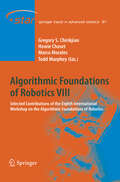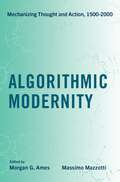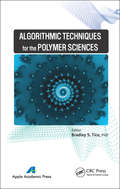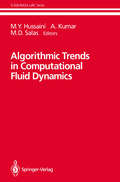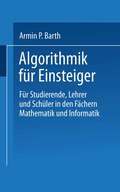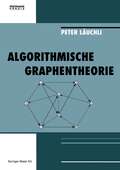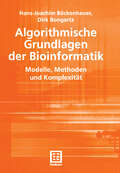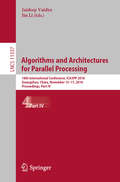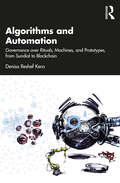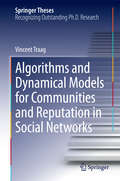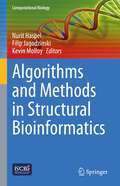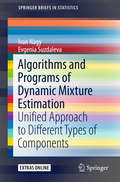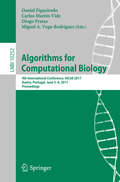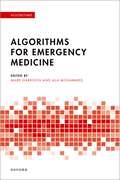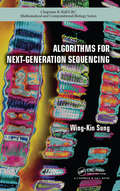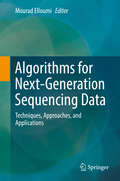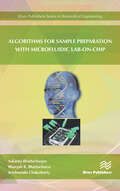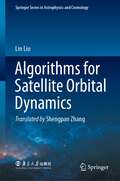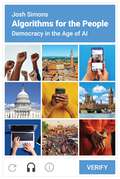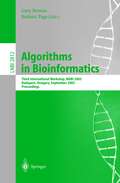- Table View
- List View
Algorithmic Foundations of Robotics VIII: Selected Contributions of the Eighth International Workshop on the Algorithmic Foundations of Robotics (Springer Tracts in Advanced Robotics #57)
by Gregory S. Chirikjian Howie Choset Marco Morales Todd MurpheyAlgorithmic Modernity: Mechanizing Thought and Action, 1500-2000
by Morgan G. Ames and Massimo MazzottiAlgorithms have been transforming human society long before the advent of computing. Yet they continue to exist in relative invisibility despite their presence behind many of our modern social interactions. The rhetoric of algorithmic neutrality is more alive than ever, and algorithms are often depicted as obvious and unproblematic—without context and without history. Algorithmic Modernity draws together the history of mathematics and intellectual history to convey the enduring global history of the algorithm as a computational tool, epistemic ideal, and rhetorical figure alongside the ascendance of modernity. Through historical reconstructions of relevant thinkers and cultural phenomena over the last five hundred years, this collection of essays reveals how algorithms became the standard method for solving problems from the early inclusion of algorithms in Newton's formation of calculus to their later influence in the New Deal economy. Together, these essays create an informed history for readers interested in the social and cultural implications of today's pervasive digital algorithm. Featuring experts in mathematics, history, and computing, Algorithmic Modernity presents a multi-faceted exploration of the genealogy of algorithmic thinking in modern times.
Algorithmic Modernity: Mechanizing Thought and Action, 1500-2000
Algorithms have been transforming human society long before the advent of computing. Yet they continue to exist in relative invisibility despite their presence behind many of our modern social interactions. The rhetoric of algorithmic neutrality is more alive than ever, and algorithms are often depicted as obvious and unproblematic—without context and without history. Algorithmic Modernity draws together the history of mathematics and intellectual history to convey the enduring global history of the algorithm as a computational tool, epistemic ideal, and rhetorical figure alongside the ascendance of modernity. Through historical reconstructions of relevant thinkers and cultural phenomena over the last five hundred years, this collection of essays reveals how algorithms became the standard method for solving problems from the early inclusion of algorithms in Newton's formation of calculus to their later influence in the New Deal economy. Together, these essays create an informed history for readers interested in the social and cultural implications of today's pervasive digital algorithm. Featuring experts in mathematics, history, and computing, Algorithmic Modernity presents a multi-faceted exploration of the genealogy of algorithmic thinking in modern times.
Algorithmic Techniques for the Polymer Sciences
by Bradley S. TiceThis new book-the first of its kind-examines the use of algorithmic techniques to compress random and non-random sequential strings found in chains of polymers. The book is an introduction to algorithmic complexity. Examples taken from current research in the polymer sciences are used for compression of like-natured properties as found on a chain o
Algorithmic Trends in Computational Fluid Dynamics (ICASE NASA LaRC Series)
by M. Y. Hussaini A. Kumar SalasAlgorithmik für Einsteiger: Für Studierende, Lehrer und Schüler in den Fächern Mathematik und Informatik
by Armin P. BarthDieses Buch bietet eine Einführung in das mathematische Spezialgebiet der Algorithmik. Der Leser erfährt, was genau ein Algorithmus ist, und hat die Möglichkeit, aus zahlreichen historisch wichtigen oder aktuellen Beispielen von Algorithmen auszuwählen. Eine Untersuchung darüber, ob und wie Algorithmen noch beschleunigt werden können, mündet in eine kurze Einführung in die moderne mathematische Disziplin der "Komplexitätstheorie". Mit der Turing-Maschine wird ein einfaches und zugleich ungeheuer mächtiges theoretisches Computermodell vorgestellt, das Anlass zu interessanten Fragen über die Möglichkeiten und Grenzen der Computer gibt.
Algorithmische Grundlagen der Bioinformatik: Modelle, Methoden und Komplexität (XLeitfäden der Informatik)
by Hans-Joachim Böckenhauer Dirk BongartzErlernen Sie die Grundlagen der Bioinformatik theoretisch fundiert und zugleich anschaulich mit vielen Beispielen. Die Bioinformatik hat in den vergangenen Jahren eine immer höhere Aufmerksamkeit erhalten. Dazu haben viele Großprojekten wie zum Beispiel das Human Genome Project beigetragen. Dieser Trend setzt sich durch immer neue und verfeinerte Ansätze zur Gewinnung und Analyse molekularbiologischer Daten fort.
Algorithms and Architectures for Parallel Processing: 18th International Conference, ICA3PP 2018, Guangzhou, China, November 15-17, 2018, Proceedings, Part IV (Lecture Notes in Computer Science #11337)
by Jaideep Vaidya Jin LiThe four-volume set LNCS 11334-11337 constitutes the proceedings of the 18th International Conference on Algorithms and Architectures for Parallel Processing, ICA3PP 2018, held in Guangzhou, China, in November 2018. The 141 full and 50 short papers presented were carefully reviewed and selected from numerous submissions. The papers are organized in topical sections on Distributed and Parallel Computing; High Performance Computing; Big Data and Information Processing; Internet of Things and Cloud Computing; and Security and Privacy in Computing.
Algorithms and Automation: Governance over Rituals, Machines, and Prototypes, from Sundial to Blockchain
by Denisa Reshef KeraTo enact the book’s central theme of automation and human agency, the author designed a Bot trained on her book to support dialogue with the content and facilitate discussions. If you like to compare what the author says and Bot ‘interprets’ or generates, go here https://www.anonette.net/denisaBot/ Algorithms and Automation: Governance over Rituals, Machines, and Prototypes, from Sundial to Blockchain is a critical examination of the history and impact of automation on society. It provides thought-provoking perspectives on the history of automation and its relationship with power, emphasizing the importance of considering the social context in which automation is developed and used. The book argues that automation has always been a political and social force that shapes our lives and futures, rather than a neutral tool. The author provides a genealogy of automation, tracing its development from ancient rituals to modern-day prototypes, and highlights the challenges posed by new technologies such as blockchain and artificial intelligence. The volume argues that we need more democratic and accountable governance over technological innovation to ensure that it respects human rights, political pluralism, legitimacy, and other values we hold dear in our institutions and political processes. An engaging read on a fascinating topic, this book will be indispensable for scholars, students, and researchers of science and technology studies, digital humanities, politics and governance, public policy, social policy, system design and automation, and history and philosophy of science and technology. It will also be of interest to readers interested in the interactions of the sciences and the social sciences and humanities.
Algorithms and Automation: Governance over Rituals, Machines, and Prototypes, from Sundial to Blockchain
by Denisa Reshef KeraTo enact the book’s central theme of automation and human agency, the author designed a Bot trained on her book to support dialogue with the content and facilitate discussions. If you like to compare what the author says and Bot ‘interprets’ or generates, go here https://www.anonette.net/denisaBot/ Algorithms and Automation: Governance over Rituals, Machines, and Prototypes, from Sundial to Blockchain is a critical examination of the history and impact of automation on society. It provides thought-provoking perspectives on the history of automation and its relationship with power, emphasizing the importance of considering the social context in which automation is developed and used. The book argues that automation has always been a political and social force that shapes our lives and futures, rather than a neutral tool. The author provides a genealogy of automation, tracing its development from ancient rituals to modern-day prototypes, and highlights the challenges posed by new technologies such as blockchain and artificial intelligence. The volume argues that we need more democratic and accountable governance over technological innovation to ensure that it respects human rights, political pluralism, legitimacy, and other values we hold dear in our institutions and political processes. An engaging read on a fascinating topic, this book will be indispensable for scholars, students, and researchers of science and technology studies, digital humanities, politics and governance, public policy, social policy, system design and automation, and history and philosophy of science and technology. It will also be of interest to readers interested in the interactions of the sciences and the social sciences and humanities.
Algorithms and Dynamical Models for Communities and Reputation in Social Networks (Springer Theses)
by Vincent TraagA persistent problem when finding communities in large complex networks is the so-called resolution limit. This thesis addresses this issue meticulously, and introduces the important notion of resolution-limit-free. Remarkably, only few methods possess this desirable property, and this thesis puts forward one such method. Moreover, it discusses how to assess whether communities can occur by chance or not. One aspect that is often ignored in this field is treated here: links can also be negative, as in war or conflict. Besides how to incorporate this in community detection, it also examines the dynamics of such negative links, inspired by a sociological theory known as social balance. This has intriguing connections to the evolution of cooperation, suggesting that for cooperation to emerge, groups often split in two opposing factions. In addition to these theoretical contributions, the thesis also contains an empirical analysis of the effect of trading communities on international conflict, and how communities form in a citation network with positive and negative links.
Algorithms and Methods in Structural Bioinformatics (Computational Biology)
by Nurit Haspel Filip Jagodzinski Kevin MolloyThe three-dimensional structure and function of molecules present many challenges and opportunities for developing an understanding of biological systems. With the increasing availability of molecular structures and the advancing accuracy of structure predictions and molecular simulations, the space for algorithmic advancement on many analytical and predictive problems is both broad and deep. To support this field, a rich set of methods and algorithms are available, addressing a variety of important problems such as protein-protein interactions, the effect of mutations on protein structure and function, and protein structure determination. Despite recent advancements in the field, in particular in protein folding with the development of AlphaFold, many problems still remain unsolved.In this book we focus on a number of topics in Structural Bioinformatics: Cryo-EM structural detection, protein conformational exploration, elucidation of molecular binding surface using geometry, the effect of mutations, insertions and deletions on protein structural stability, and protein-ligand binding.
Algorithms and Programs of Dynamic Mixture Estimation: Unified Approach to Different Types of Components (SpringerBriefs in Statistics)
by Ivan Nagy Evgenia SuzdalevaThis book provides a general theoretical background for constructing the recursive Bayesian estimation algorithms for mixture models. It collects the recursive algorithms for estimating dynamic mixtures of various distributions and brings them in the unified form, providing a scheme for constructing the estimation algorithm for a mixture of components modeled by distributions with reproducible statistics. It offers the recursive estimation of dynamic mixtures, which are free of iterative processes and close to analytical solutions as much as possible. In addition, these methods can be used online and simultaneously perform learning, which improves their efficiency during estimation. The book includes detailed program codes for solving the presented theoretical tasks. Codes are implemented in the open source platform for engineering computations. The program codes given serve to illustrate the theory and demonstrate the work of the included algorithms.
Algorithms for Computational Biology: 4th International Conference, AlCoB 2017, Aveiro, Portugal, June 5-6, 2017, Proceedings (Lecture Notes in Computer Science #10252)
by Daniel Figueiredo, Carlos Martín-Vide, Diogo Pratas and Miguel A. Vega-RodríguezThis book constitutes the proceedings of the 4th InternationalConference on Algorithms for Computational Biology, AlCoB 2017, held in Aveiro, Portugal, in June 2017. The 10 full papers presented together with 2 invited papers were carefully reviewed and selected from 24 submissions. They are organized in the following topical sections: Graph Algorithms for Computational Biology; Phylogenetics; and Sequence Analysis and Other Biological Processes.
Algorithms for Emergency Medicine (Algorithms In)
by Mark Harrison and Ala MohammedDelivering Emergency Medicine involves constant challenges to the emergency clinician, seen in the frequency of severely unwell patients, the wide breadth of conditions encountered, and the urgency required in diagnosis and treatment. Concise, and, critically, accessible, Algorithms for Emergency Medicine supports the key decision-making requirements of clinicians working in the Emergency Department. Designed to support rapid problem solving, this resource covers everything from common non-life-threatening emergencies such as headaches to life-threatening acute events such as major traumas. Each topic is divided into two; the left page provides essential knowledge, and on the right, an algorithm which guides the clinician in a step by step process in managing these conditions. Evidence based and up-to-date, this book follows the College of Emergency Medicine Curriculum, making it an invaluable resource for Emergency Nurse Practitioners, new doctors starting their placement in the Emergency Department, and trainee doctors working towards specialising in Emergency Medicine.
Algorithms for Emergency Medicine (Algorithms In)
Delivering Emergency Medicine involves constant challenges to the emergency clinician, seen in the frequency of severely unwell patients, the wide breadth of conditions encountered, and the urgency required in diagnosis and treatment. Concise, and, critically, accessible, Algorithms for Emergency Medicine supports the key decision-making requirements of clinicians working in the Emergency Department. Designed to support rapid problem solving, this resource covers everything from common non-life-threatening emergencies such as headaches to life-threatening acute events such as major traumas. Each topic is divided into two; the left page provides essential knowledge, and on the right, an algorithm which guides the clinician in a step by step process in managing these conditions. Evidence based and up-to-date, this book follows the College of Emergency Medicine Curriculum, making it an invaluable resource for Emergency Nurse Practitioners, new doctors starting their placement in the Emergency Department, and trainee doctors working towards specialising in Emergency Medicine.
Algorithms for Next-Generation Sequencing (Chapman & Hall/CRC Computational Biology Series)
by Wing-Kin SungAdvances in sequencing technology have allowed scientists to study the human genome in greater depth and on a larger scale than ever before – as many as hundreds of millions of short reads in the course of a few days. But what are the best ways to deal with this flood of data? Algorithms for Next-Generation Sequencing is an invaluable tool for students and researchers in bioinformatics and computational biology, biologists seeking to process and manage the data generated by next-generation sequencing, and as a textbook or a self-study resource. In addition to offering an in-depth description of the algorithms for processing sequencing data, it also presents useful case studies describing the applications of this technology.
Algorithms for Next-Generation Sequencing (Chapman & Hall/CRC Computational Biology Series)
by Wing-Kin SungAdvances in sequencing technology have allowed scientists to study the human genome in greater depth and on a larger scale than ever before – as many as hundreds of millions of short reads in the course of a few days. But what are the best ways to deal with this flood of data? Algorithms for Next-Generation Sequencing is an invaluable tool for students and researchers in bioinformatics and computational biology, biologists seeking to process and manage the data generated by next-generation sequencing, and as a textbook or a self-study resource. In addition to offering an in-depth description of the algorithms for processing sequencing data, it also presents useful case studies describing the applications of this technology.
Algorithms for Next-Generation Sequencing Data: Techniques, Approaches, and Applications
by Mourad ElloumiThe 14 contributed chapters in this book survey the most recent developments in high-performance algorithms for NGS data, offering fundamental insights and technical information specifically on indexing, compression and storage; error correction; alignment; and assembly. The book will be of value to researchers, practitioners and students engaged with bioinformatics, computer science, mathematics, statistics and life sciences.
Algorithms for Sample Preparation with Microfluidic Lab-on-Chip
by Sukanta Bhattacharjee Bhargab B. Bhattacharya Krishnendu ChakrabartyRecent microfluidic technologies have brought a complete paradigm shift in automating biochemical processing on a tiny lab-on-chip (a.k.a. biochip) that replaces expensive and bulky instruments traditionally used in implementing bench-top laboratory protocols. Biochips have already made a profound impact on various application domains such as clinical diagnostics, DNA analysis, genetic engineering, and drug discovery, among others. They are capable of precisely manipulating micro-/pico-liter quantities of fluids, and provide integrated support for mixing, storage, transportation, and sensing, on-chip. In almost all bioprotocols, sample preparation plays an important role, which includes dilution and mixing of several fluids satisfying certain volumetric ratios. However, designing algorithms that minimize reactant-cost and sample-preparation time suited for microfluidic chips poses a great challenge from the perspective of protocol mapping, scheduling, and physical design. Algorithms for Sample Preparation with Microfluidic Lab-on-Chip attempts to bridge the widening gap between biologists and engineers by introducing, from the fundamentals, several state-of-the-art computer-aided-design (CAD) algorithms for sample preparation with digital and flow-based microfluidic biochips. Technical topics discussed in the book include: Basics of digital and flow-based microfluidic lab-on-chipComprehensive review of state-of-the-art sample preparation algorithmsSample-preparation algorithms for digital microfluidic lab-on-chipSample-preparation algorithms for flow-based microfluidic lab-on-chip
Algorithms for Sample Preparation with Microfluidic Lab-on-Chip
by Sukanta Bhattacharjee Bhargab B. Bhattacharya Krishnendu ChakrabartyRecent microfluidic technologies have brought a complete paradigm shift in automating biochemical processing on a tiny lab-on-chip (a.k.a. biochip) that replaces expensive and bulky instruments traditionally used in implementing bench-top laboratory protocols. Biochips have already made a profound impact on various application domains such as clinical diagnostics, DNA analysis, genetic engineering, and drug discovery, among others. They are capable of precisely manipulating micro-/pico-liter quantities of fluids, and provide integrated support for mixing, storage, transportation, and sensing, on-chip. In almost all bioprotocols, sample preparation plays an important role, which includes dilution and mixing of several fluids satisfying certain volumetric ratios. However, designing algorithms that minimize reactant-cost and sample-preparation time suited for microfluidic chips poses a great challenge from the perspective of protocol mapping, scheduling, and physical design. Algorithms for Sample Preparation with Microfluidic Lab-on-Chip attempts to bridge the widening gap between biologists and engineers by introducing, from the fundamentals, several state-of-the-art computer-aided-design (CAD) algorithms for sample preparation with digital and flow-based microfluidic biochips. Technical topics discussed in the book include: Basics of digital and flow-based microfluidic lab-on-chipComprehensive review of state-of-the-art sample preparation algorithmsSample-preparation algorithms for digital microfluidic lab-on-chipSample-preparation algorithms for flow-based microfluidic lab-on-chip
Algorithms for Satellite Orbital Dynamics (Springer Series in Astrophysics and Cosmology)
by Lin LiuThis book highlights the fundamental physics of orbit theory, dynamical models, methods of orbit determination, design, measurement, adjustment, and complete calculations for the position, tracking, and prediction of satellites and deep spacecraft. It emphasizes specific methods, related mathematical calculations, and worked examples and exercises. Therefore, technicians and engineers in the aerospace industry can directly apply them to their practical work. Dedicated to undergraduate students and graduate students, researchers, and professionals in astronomy, physics, space science, and related aerospace industries, the book is an integrated work based on the accumulated knowledge in satellite orbit dynamics and the author’s more than five decades of personal research and teaching experience in astronomy and aerospace dynamics.
Algorithms for the People: Democracy in the Age of AI
by Josh SimonsHow to put democracy at the heart of AI governanceArtificial intelligence and machine learning are reshaping our world. Police forces use them to decide where to send police officers, judges to decide whom to release on bail, welfare agencies to decide which children are at risk of abuse, and Facebook and Google to rank content and distribute ads. In these spheres, and many others, powerful prediction tools are changing how decisions are made, narrowing opportunities for the exercise of judgment, empathy, and creativity. In Algorithms for the People, Josh Simons flips the narrative about how we govern these technologies. Instead of examining the impact of technology on democracy, he explores how to put democracy at the heart of AI governance.Drawing on his experience as a research fellow at Harvard University, a visiting research scientist on Facebook’s Responsible AI team, and a policy advisor to the UK’s Labour Party, Simons gets under the hood of predictive technologies, offering an accessible account of how they work, why they matter, and how to regulate the institutions that build and use them.He argues that prediction is political: human choices about how to design and use predictive tools shape their effects. Approaching predictive technologies through the lens of political theory casts new light on how democracies should govern political choices made outside the sphere of representative politics. Showing the connection between technology regulation and democratic reform, Simons argues that we must go beyond conventional theorizing of AI ethics to wrestle with fundamental moral and political questions about how the governance of technology can support the flourishing of democracy.
